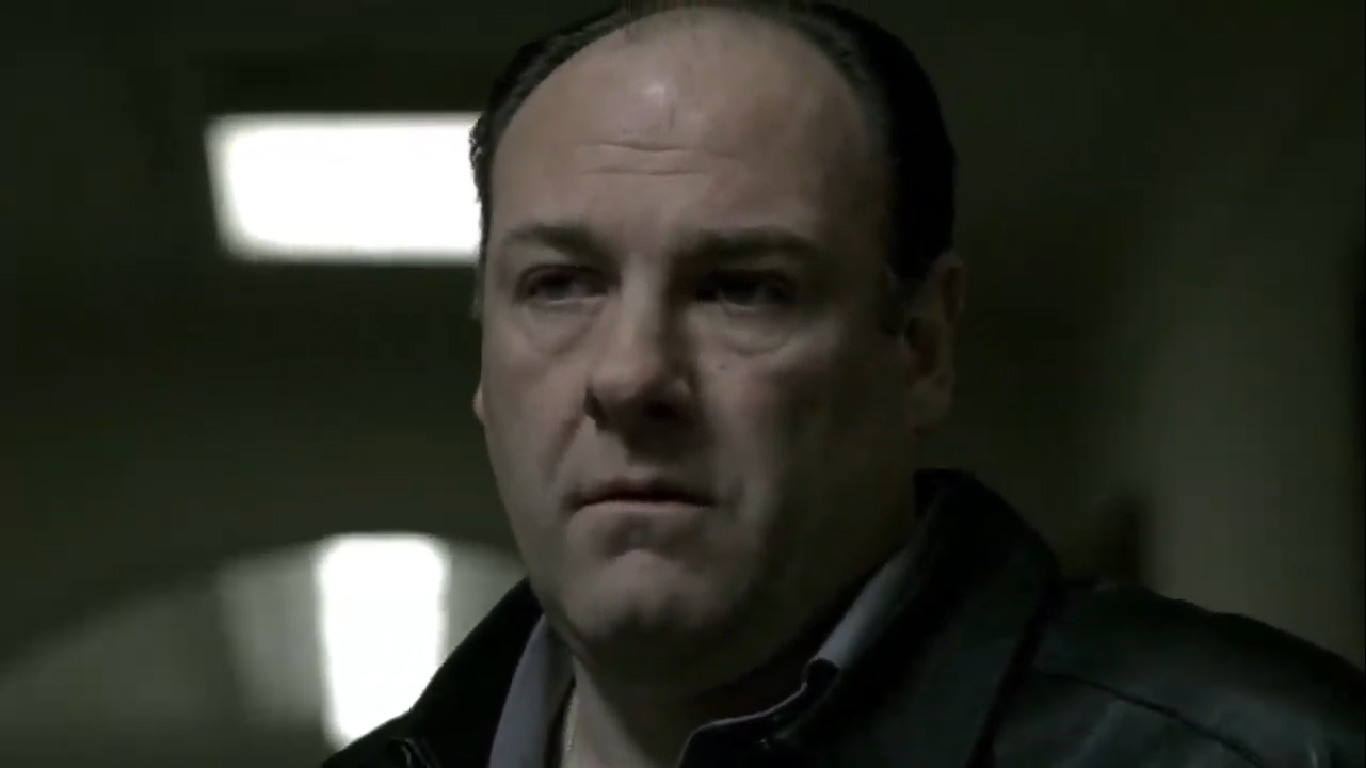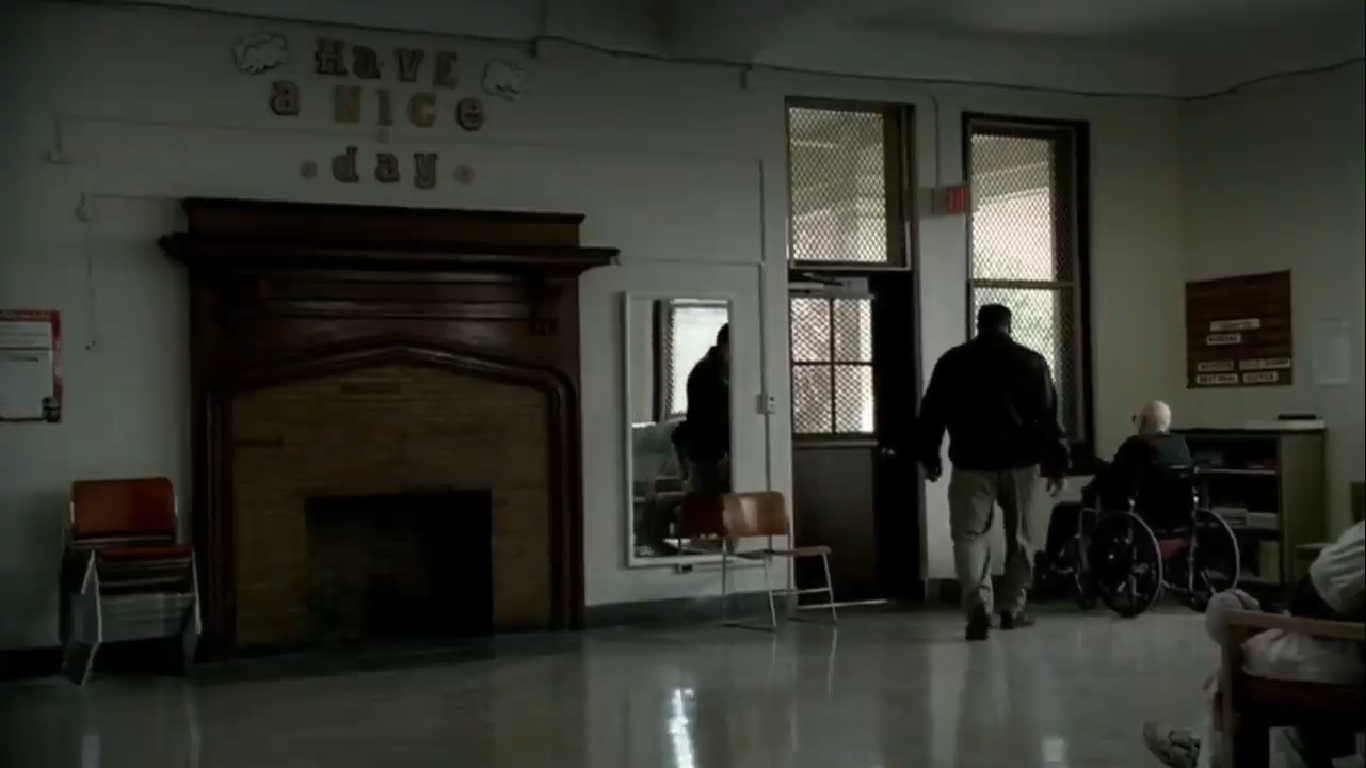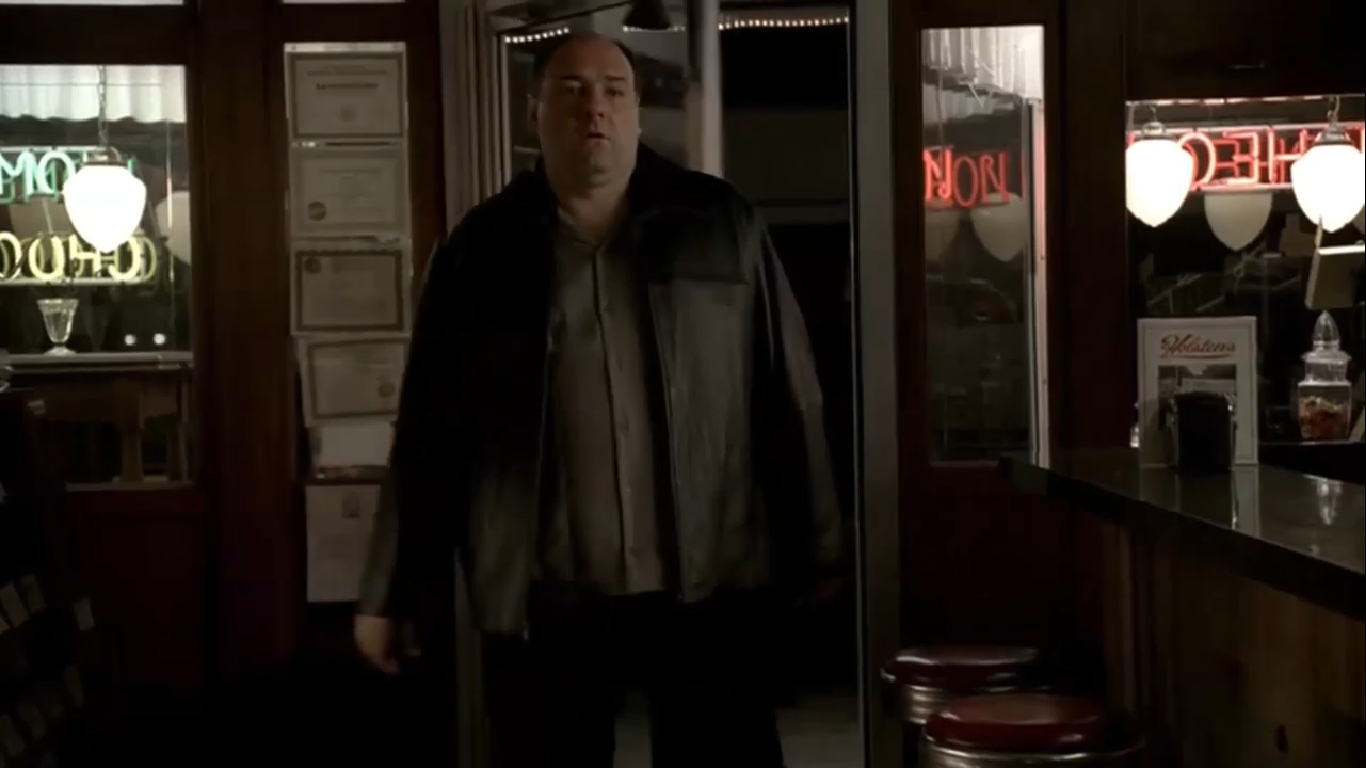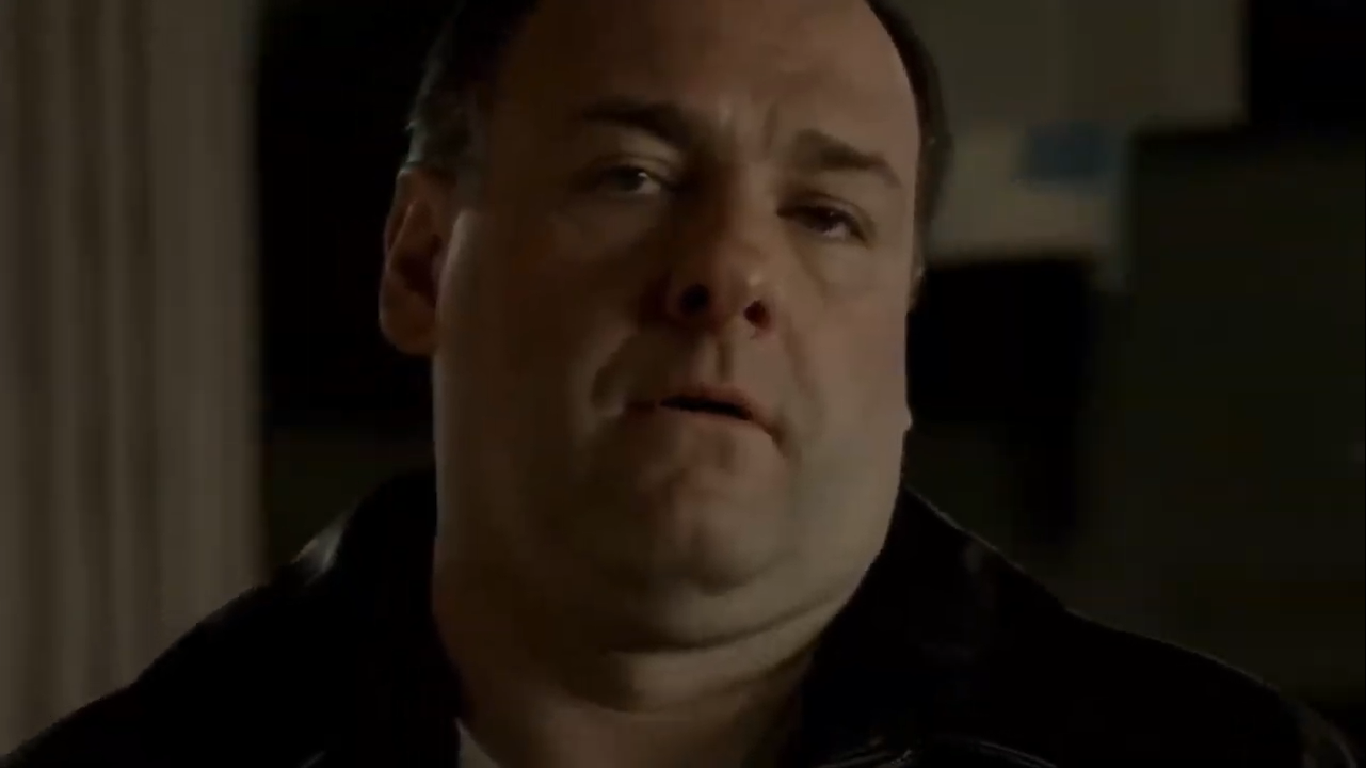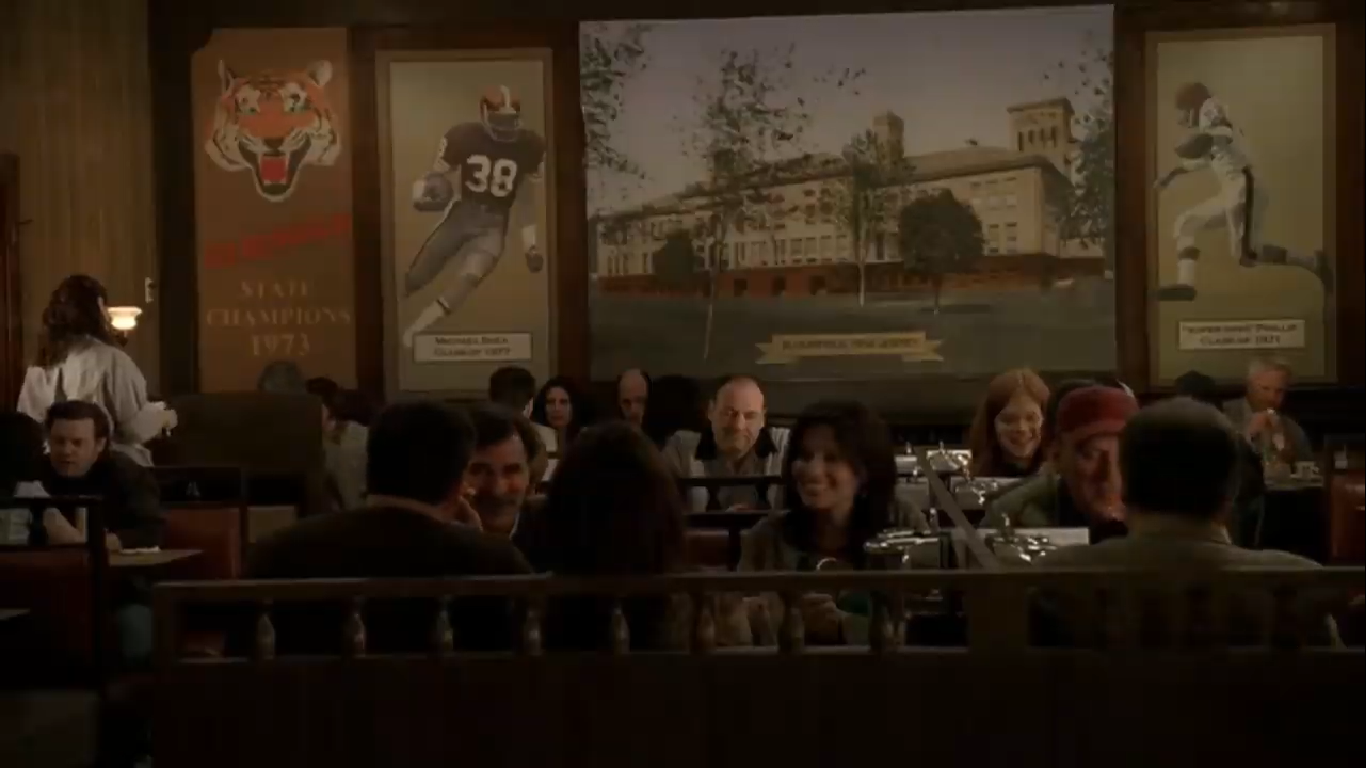Page 2
Update 6/10/15: On the eight year anniversary of the Sopranos finale, please enjoy the new Annotated Guide to the Final Scene where every single shot of the final scene is analyzed with quotes from Chase(including his new comments to the DGA). Consider it a “cliff notes” version of Part 1 of this site. Go here to read and here for page 2
Tony is not “looking over his shoulder” and only MOG is a potential threat. These boy scouts and young couple in love don’t exactly seem threatening:

“Man in USA Cap” is minding his own business

Chase gives us a multitude of shots of Tony just looking down. Tony is content as he grabs A.J.’s hand:

Tony is happy as he makes a connection with his son. Chase sets up this rare, happy moment for Tony with his family, so that the scene becomes about what Tony has lost when he is killed (see part two of this piece).
Furthermore, from a storytelling standpoint, it does not make much sense that Chase, who planned the ending years in advance, would use the final scene to simply make the statement that “this is how Tony will have to live the rest of his life.” The viewers already know Tony will always have to look over his shoulder. The viewers have known this since the beginning (Tony is mafia boss!). Chase could have created a Tony POV sequence to convey this message in any of the other 86 episodes. It makes much more sense that the Tony POV sequence was created to put the viewer in Tony’s eyes at the exact moment of his death. Remember, Tony Soprano is the main character the viewer has followed all of these years. We have been inside his head in multiple dream sequences and have intimate knowledge of his personality and fears through his visits to Dr. Melfi. It makes sense to put the viewer in Tony’s POV at the time of his death. Once Tony is dead, there is no show. If Tony was to die it had to be the last moment of the series. The show ends where Tony’s consciousness ends.
So the last shot of the series is from Tony’s POV. Tony does not hear the bullet as it was shot from close range and traveled faster than the speed of sound (i.e. the bullet hit his brain before his brain could process the sound). Tony never heard it coming. No chance to reflect or react. The bullet shattered his brain and there was instantaneous death. Just a void of blackness and nothingness. Worse, his family was there to be bear witness to his murder. The viewer experienced death through Tony’s eyes and it was jarring. Upon further inspection we see that Chase set up this moment by deliberately planting the “never hear it concept” into the viewer throughout the final 9 episodes. *
*One last note on the POV sequence/Blackout. Just after the finale aired, blogs on the internet contained numerous posts from viewers swearing they saw Meadow walk through the door just before the abrupt cut to black. The question arose whether Chase had two different versions of the final scene shown across the country. One with Tony’s face as the last thing we see before the blackout and the other being Meadow walking into Holsten’s before the famous cut to black. We now know that there was only one version shown. Surely someone would have recorded this alternate version if it existed. There is actually a simple explanation for this misconception and it all has to do with the POV sequence explained above. The POV pattern caused the viewer to expect to see who was coming through the door from Tony’s POV. When the bell rang, Tony looked up. Our brains were conditioned by Chase to think that we were going to see Meadow. In a sense this was a Pavlovian type response. The fact that so many thought the last shot was Meadow is a tribute to David Chase and how effective his POV pattern really was.
By putting us in Tony’s eyes in the last shot we know that Tony never heard the bullet. However, Chase has already told us what to expect from first-person death. Most significantly from a scene originally shown in the first episode of the second part of the final season titled “Sopranos Home Movies” and repeated via flashback at the end of the penultimate episode “The Blue Comet.” In “Sopranos Home Movies,” Tony talks to Bacala about how most mob bosses either end up dead or in jail. Bacala then refers to death in the mafia and asks Tony: “You probably don’t even hear it when it happens, right?” At the closing scene of “The Blue Comet,” Tony has a flashback to that moment. The show rarely uses flashback so this would seem to have major significance. Chase sets up the end of “Made in America” with this flashback. Bacala asked a question that Tony can now answer: Tony never heard it coming. Bacala’s words corroborate Tony’s experience at the moment of his death.
Bacala questions Tony about death in the mafia: “You probably don’t even hear it when it happens, right?”
The final moments of the second to last episode “The Blue Comet”. At 2:16, Tony’s ominous flashback to Bacala’s “You probably never hear it when it happens, right?”:
The final season episode “Stage 5” also foreshadows Tony’s death and furthers the “never hear it happen” concept with the murder of Gerry Torciano. Gerry is having a sit-down with Silvio at a restaurant. Both characters have their “goomars” (girlfriends to married mafia men) at the table with them. At one point, Chase shows us an over the shoulder “goomar” POV shot of Silvio talking to her. Torciano cannot be seen at all in the shot as Silvio fills the screen. Suddenly, the sound cuts off and a low ringing is heard as blood is sprayed on Silvio while he continues to talk to his goomar while seemingly unaware of the blood. The scene also slows down for a few moments. Silvio then looks down and sees blood on himself and seems surprised, disoriented and confused (Silvio, nor us, have heard any gun shots). Finally, Silvio looks up and Chase cuts to a hit-man blasting Gerry in the side of the head as the sound returns. Both goomars hold their ears as the guns blast (the sound cutting off and the low ringing may simulate the auditory experience of being so close to the gun blasts). Here, Chase is having the viewer share the POV of a witness at the dinner table (Silvio’s goomar). More importantly, Silvio never heard or saw it coming. This scene sets up (1) Tony’s POV in Holsten’s and (2) another unexpected murder in a restaurant in which the victim nor anybody else “heard coming.”
Later in the episode, Silvio tells Tony about the Torciano murder and says “fucking scary thing was I didn’t know what happened until after the shot was fired. Fucking weird.” His words echo Bacala’s “never hear it when it happens.” The follow up scene where Silvio relays his experience to Tony seemingly has no practical significance: we know Silvio did not know what happened until after the shot was fired, we saw the scene. Chase’s purpose for Silvio’s explanation to Tony (just like Bacala told Tony) is to hammer home the “never hear it happen” concept into the viewer because it will pay off in the final scene. Also of note is that Silvio’s words correctly predict the viewer’s reaction to the final scene: The fans of the show would not know what happened until after the shot was fired at Holsten’s. Chase was setting us up the whole time.
Silvio talks to his goomar and doesn’t hear the shots until he is already covered in blood. Here is the sequence: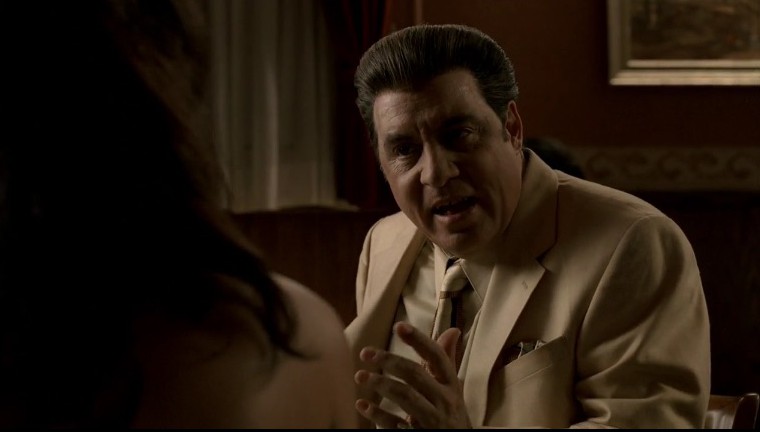


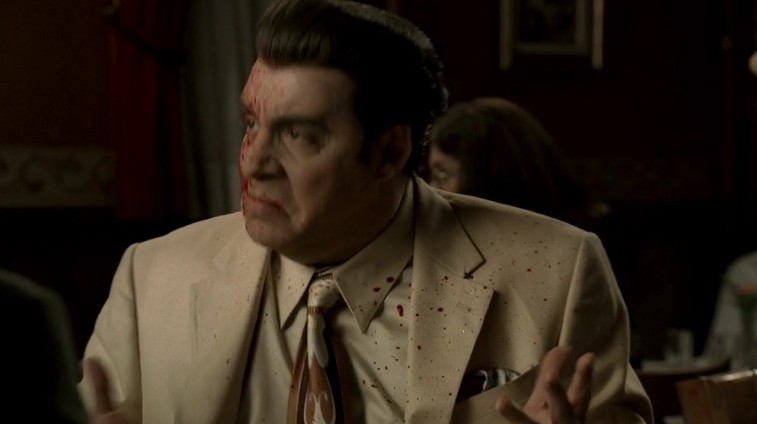

Silvio relays his experience to Tony: “Fucking scary thing was I didn’t know what happened until after the shot was fired. [That’s] fucking weird.” His words echo Bacala’s “never hear it happen.”
Silvio “never hears it”: watch the scene referenced by Chase as connected to the ending:
Chase, in an interview with Brett Martin for the HBO Sopranos final edition book, confirmed the significance of the Torciano scene:
Question: Are they wasting their time? Is there a puzzle to be solved [to the end]?
Chase: There are no esoteric clues in there. No Da Vinci Code. Everything that pertains to that episode was in that episode. And it was in the episode before that and the one before that and seasons before this one and so on. There had been indications of what the end is like. Remember when Jerry Torciano was killed? Silvio was not aware that the gun had been fired until after Jerry was on his way down to the floor. That’s the way things happen: It’s already going on by the time you even notice it.
Question: Are you saying [Tony died]…?
Chase: I’m not saying anything. I’m not trying to be coy. It’s just that I think that to explain it would diminish it.
Furthermore, from an “Air America” radio interview of David Chase conducted by Richard Belzer on April 14, 2008:
Richard Belzer: I was working with Steve Schirripa [Bacala] recently. We were judging “Last Coming Standing” for NBC and we were talking about a lot of things and he was saying he heard all of these theories for the show that had nothing to do with your intention and wasn’t anything the actors thought. Like little hints along the way, like a word, like when Tony and Steve are on the boat at the lake and they say “‘you never know its gonna happen” or “you never know its gonna hit you”
David Chase: That was part of the ending.
Richard Belzer: Oh, it was? see, what do I know? Were there other things in previous episodes that were hints towards it?
David Chase: There was that and there was a shooting in which Silvio was a witness. Well he wasn’t a witness, he was eating dinner with a couple of hookers and with some other guy who got hit and there was some visual stuff that went on there which sort of amplified Tony’s remark to Bacala about you know “you don’t know its happened” or “you won’t know it happened when it hits you”. That’s about it.
Richard Belzer: That’s what John Kennedy said.
Audio of the David Chase interview by Richard Belzer; go to 4:27:
The “never hear it concept” is expressed by Chase throughout the final episode. Phil is killed in almost the exact same way as Tony. Phil is shot in the side of the head and presumably “never heard it coming.” Tony’s vulnerability from behind (MOG shoots Tony from behind) to set up Tony “never hearing it happen” is consistently foreshadowed in “Made in America.” Chase does this in two separate scenes. The first scene is the sit-down with New York where NY boss “George” is the mediator. George asks Tony if he wants water which is behind Tony. In response, Tony does a fast “spin around” to see what is behind him as if he is vulnerable. In the very beginning of the Tony-Junior scene, Tony is staring at Junior. An orderly behind Tony (behind his right shoulder, where MOG would be) asks Tony twice to move out of his way and raises his voice (Tony “never heard” him). Finally, Tony looks behind him and seems to be surprised to see the orderly. Furthermore, at the family’s safe house, Carmela asks Tony if he is being careful; Tony looks away and never gives Carmela an answer. In the previous episode “Blue Comet,” Tony tells Silvio to have “eyes behind the back of your head” when he is referring to Phil’s possible retaliation against Tony’s crew. Unfortunately, Tony does not take his own advice at Holsten’s.
Chase also makes explicitly showing Tony’s murder superfluous through the use of POV in the previous murders of Phil Leotardo and Gerry Torciano. In the Torciano murder, Chase shows us the POV of a witness at the table (see above). This suggests what the experience may have been like for A.J. and Carmela in the final scene. A few seconds before Phil is shot, the camera is placed behind Phil, just like the killer would be. Walden’s (the killer’s) arm and gun then enter from the side of the frame and Phil is shot in the head. The shot suggests the POV of the killer and what the experience may have been like for “Man in Members Only Jacket” in the final scene. Furthermore, Phil’s wife has a delayed reaction to Phil’s shooting (she does not start screaming until a second or two after Phil is already on the floor, even though she should clearly see the gun pointed at Phil’s head before the shot is fired), this echoes Silvio’s delayed response to the Torciano murder and our delayed response to Tony’s murder. Finally, the last scene puts us in the ultimate POV, the POV of the victim-Tony Soprano. In a sense though Chase has already shown us everything: we already know what the experience of Tony’s murder would be like for Carmela, A.J., and MOG.
Phil gets whacked in the last episode. Like Tony, he (presumably) never hears the shot to the side of his head, and dies in front of his family. Also notice the wife’s delayed reaction to his murder: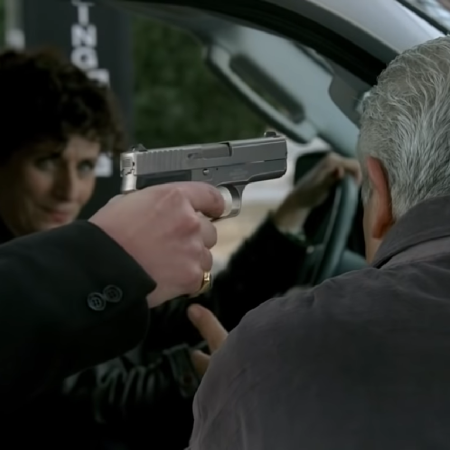
In the next three shots in sequence, Chase give us a weird scene where George offers Tony some water. The water is placed behind Tony and Tony quickly turns around as if he’s vulnerable from behind. In the final scene, Tony isn’t as careful.
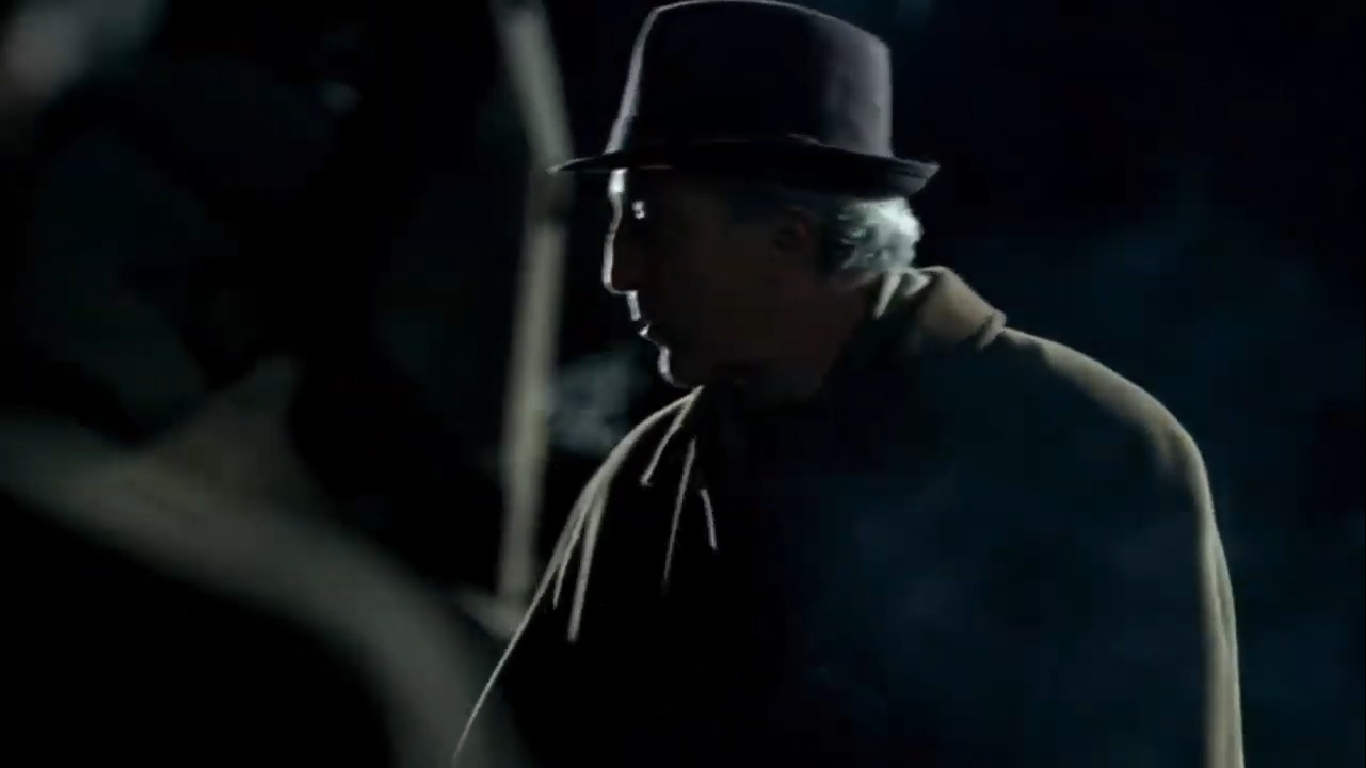
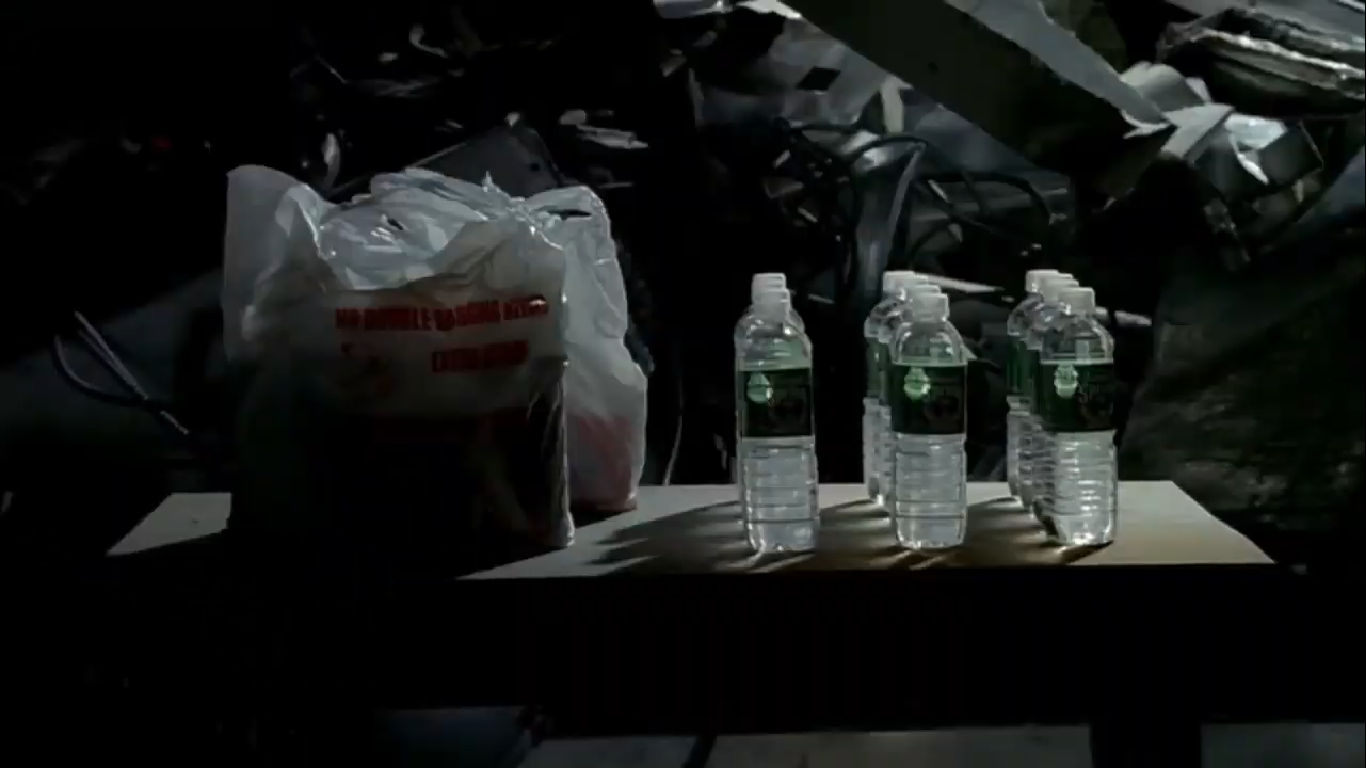
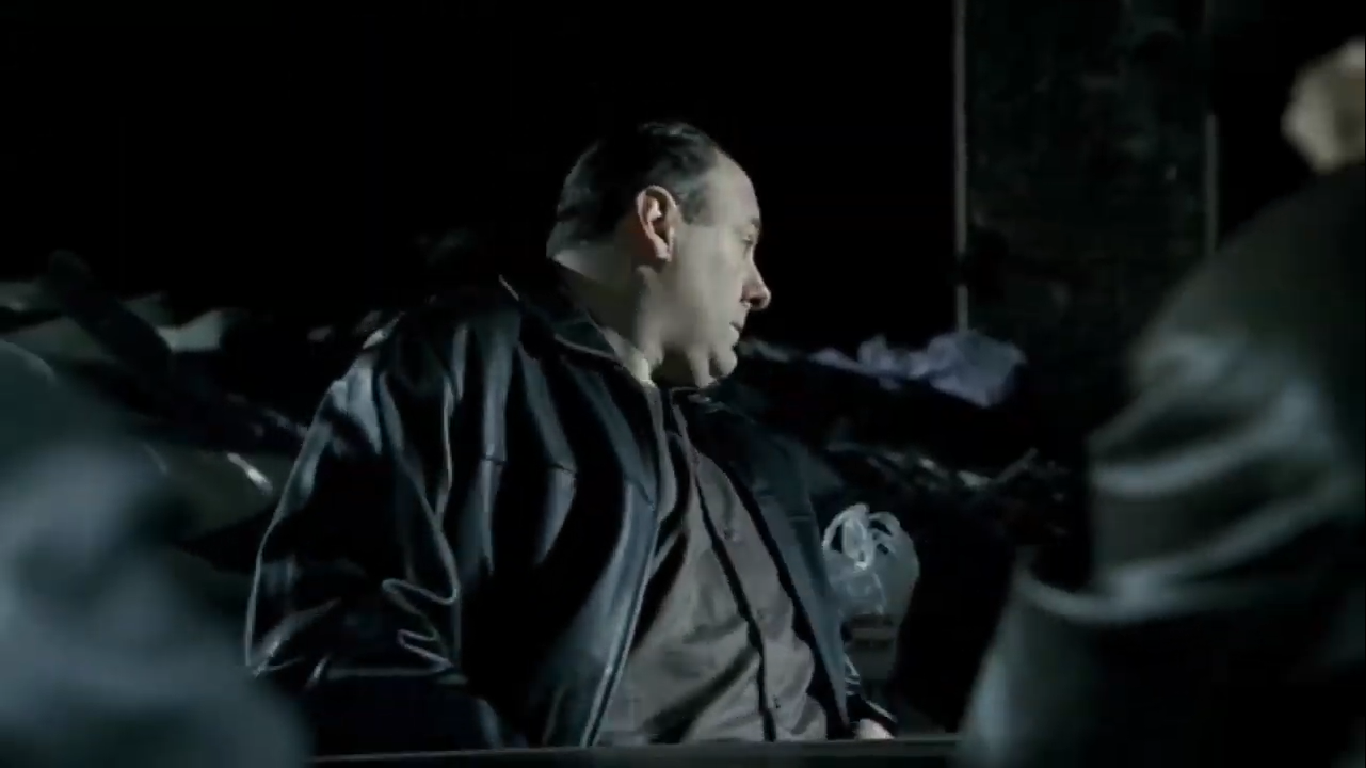 In the next shots in sequence, Tony “never hears” the orderly behind him telling him to move. Tony looks surprised when he’s sees him. This is the final scene before Holsten’s.
In the next shots in sequence, Tony “never hears” the orderly behind him telling him to move. Tony looks surprised when he’s sees him. This is the final scene before Holsten’s.

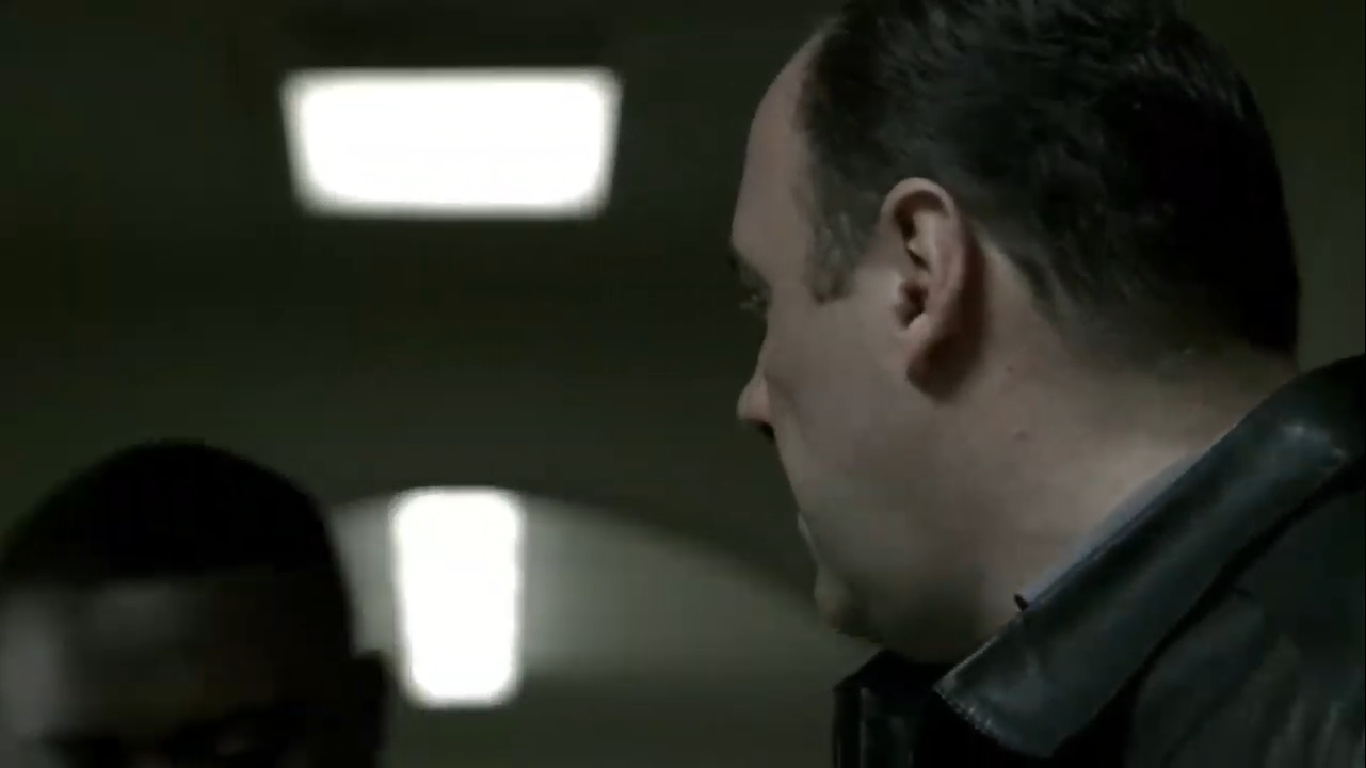
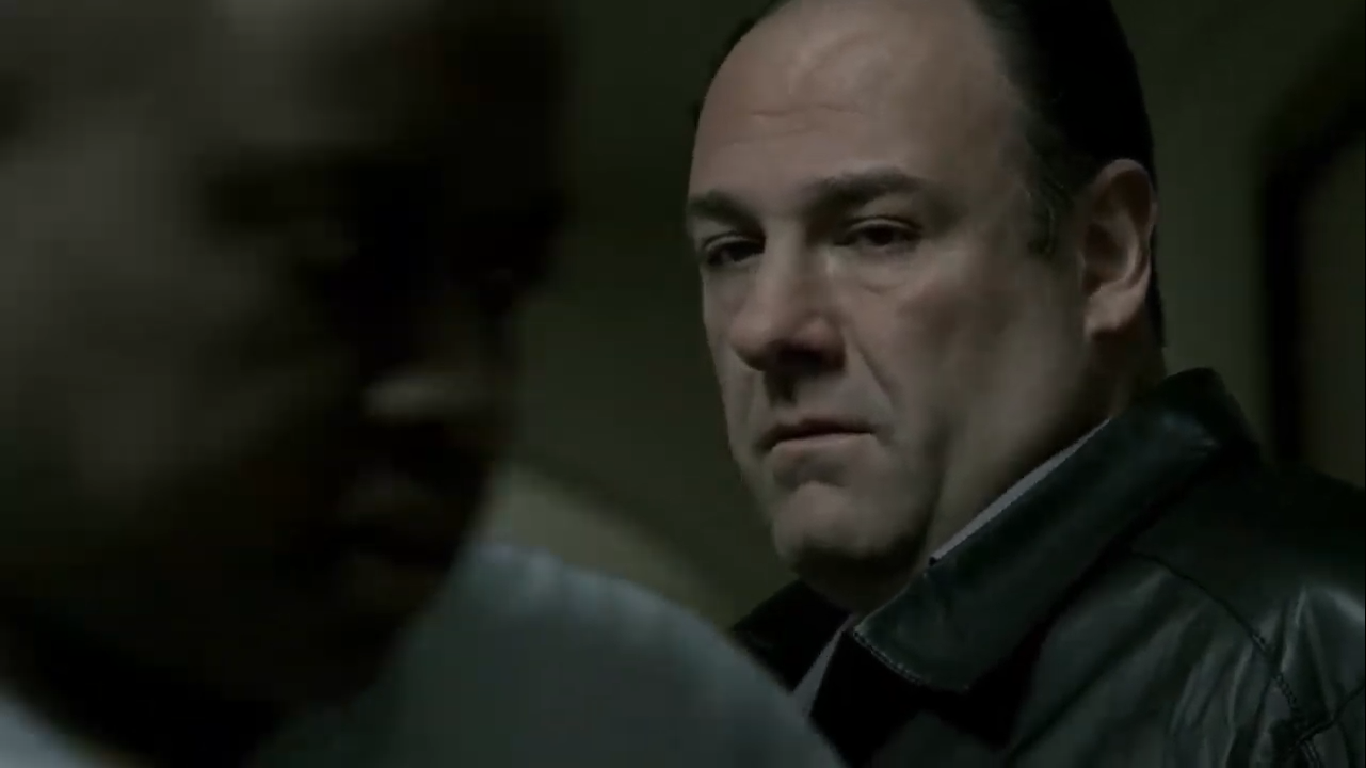
Part 1: Section B: Why David Chase chose to kill Tony in a non-traditional way. This section includes a discussion of an alternate death scene for Tony that Chase originally intended to use and very revealing comments by Chase regarding his frustration with the audience that doesn’t understand that we were meant to conclude that Tony was killed.
Technically, Tony’s death is “on screen,” but not in the way we would expect or even necessarily decipher (the black screen is Tony’s POV, or lack thereof). However, Chase has reiterated that he did not want to “show” Tony’s death in the traditional and obvious way, that being seeing MOG shoot Tony in the head in front of his family. Extensive comments from Chase, both before and after the finale aired reveal his concern that he didn’t want the ending to be perceived as a preachy “crime doesn’t pay” message. Chase believed that showing Tony’s bloody murder would incite the viewer’s righteous belief that Tony deserves to be punished. Chase wanted to avoid the cliches of the traditional, and predictable ending of the gangster “paying for his sins” or “going out in a blaze of glory” death.
Further, his comments express his concern not only that showing Tony’s bloody murder would make the scene simply about Tony receiving “justice,” but it would also satisfy the fan’s blood lust when those same fans-rather hypocritically-cheered on Tony for years. Here are Chase’s comments from October of 2007:
“There was so much more to say than could have been conveyed by an image of Tony face down in a bowl of onion rings with a bullet in his head. Or, on the other side, taking over the New York mob. The way I see it is that Tony Soprano had been people’s alter ego. They had gleefully watched him rob, kill, pillage, lie, and cheat. They had cheered him on. And then, all of a sudden, they wanted to see him punished for all that. They wanted “justice.” They wanted to see his brains splattered on the wall. I thought that was disgusting, frankly. But these people have always wanted blood. Maybe they would have been happy if Tony had killed twelve other people. Or twenty-five people. Or, who knows, if he had blown up Penn Station. The pathetic thing- to me- was how much they wanted his blood, after cheering him on for eight years”.
The quote suggests that Chase objects to the image of Tony’s death (not the idea of his death). This may be one explanation for the genesis of the POV pattern (the primary reason Chase used the POV pattern will be discussed shortly below) and the idea that we would experience death through Tony’s eyes. Chase is disgusted by the inherent contradiction that the same people who cheer on Tony also want to see his brains splattered all over the diner. He rails against fans for cheering on Tony and at the same time wanting to see his blood. By using Tony’s POV, he denies the fans the thrill of watching his bloody murder. More importantly, by putting “us,”the viewer, the same people he calls pathetic for cheering on Tony, in Tony’s eyes at the moment of death, he is indicting all of us. Most telling in the quote is that he calls the fans Tony’s “alter ego.” Chase does not allow us to be removed from Tony’s death (by seeing him shot and bloody) but gives us the same abrupt, disorienting feeling of sudden death and nothingness. We are Tony at that exact moment and it is jarring and more importantly, we deserve it for rooting for this guy. Chase was making a statement about us as well.
In 2018, David Chase was interviewed by television bloggers Matt Zoller Seitz and Alan Sepinwall for their book “The Sopranos Sessions.” In it, Chase-rather flippantly-calls the final scene a “Death Scene.” Chase doesn’t even seem to realize his confession and when called out on it, says “fuck you guys” to his interviewers. While his accidental admission should not really be a surprise to most at this point, Chase offers new information about an alternate “death scene” that ultimately was never used. The text is cited below:
Alan: But you said that you didn’t try to plan too far ahead. When you said there was an endpoint, you don’t mean Tony at Holsten’s, you just meant, “I think I have two more years of stories left in me.”
Chase: Yes. I think I had that death scene around two years before the end. I remember talking with [writer/executive producer] Mitch Burgess about it-but it wasn’t-it was slightly different. Tony was going to get called to a meeting with Johnny Sack in Manhattan and he was going to go back through the Lincoln Tunnel for this meeting, and it was going to black there, the theory being that something bad happens to him at the meeting. But we didn’t do that.
Matt: You realize, of course, that you just referred to that as a “death scene.”
[A long pause follows]
Chase: Fuck you guys.
[Matt and Alan explode with laughter after a moment Chase joins in for a good thirty seconds].
Chase: But I changed my mind over time. I didn’t want to do a straight death scene. I didn’t want you to feel like “Oh, he’s meeting with Johnny sack and he’s going to get killed”. That’s the truth of it.*
*(For any readers who have any doubt that both versions were intended to be “death scenes” (not just the first version), see these two quotes from Chase. The first is from the Daily Beast in 2014. Chase had yet to accidentally slip with the term “death scene,” but his comments, now seen in context with his later accidental admission, completely confirms that Tony was to die in either version, although the execution of that idea turned out to be slightly different:
Q: Did you toy with different endings?
Chase: No. There was an earlier version but it was basically the same thing, it just happened slightly differently).
And as discussed in the update section at the beginning of Page 1, on 11/4/21, Scott Feinberg asked Chase about both of his versions of the ending. After discussing Chase’s original version of the ending, Chase discussed when the idea came to him for his second and final version and confirmed that Tony was to die in a restaurant:
Chase: I was driving on Ocean Park Boulevard near the airport and I saw a little restaurant. It was kind of like a shack that served breakfast. And for some reason I thought “Tony should get it in a place like that.” Why? I don’t know. That was, like, two years before [the show ended].)
Chase, in “The Sopranos Sessions” interview, then continues to discuss the alternate and original “Death Scene”:
Chase: If you were producing that [tunnel scene], you’d say, “Well, obviously he’s a gangster, and his death means the end of the show, so he should die. Anyone would, so he should go through that.” But in the end, I decided I didn’t want to do that. Otherwise I would’ve filmed him going to the meeting with Johnny.
Chase explains in that last quote that his original version of the scene (which Chase describes as more of a “straight death scene”) would be perceived as a more traditional gangster death since the scene itself has Tony meeting his fate at a gangster meeting. Chase explains that that ending would simply be perceived as the preachy “crime doesn’t pay” message (as Chase explains: “obviously he’s a gangster…so he should die…so he should go through that”). The question then arises is what is the distinction for Chase between the original death scene and what we ultimately saw in Holsten’s-a scene showed partially through Tony’s POV while he eats dinner with his family, and then ends with the audience sharing Tony’s POV at the moment of his death. Extensive comments from Chase will bring his thought process into focus and explain his main purpose in executing the scene the way he did:
David Chase’s comments on the final scene to Jack Coyle of the Associated Press in 2012:
“Tony was dealing in mortality every day. He was dishing out life and death. And he was not happy. He was getting everything he wanted, that guy, but he wasn’t happy. All I wanted to do was present the idea of how short life is and how precious it is. The only way I felt I could do that was to rip it away.”
Chase explains here that the ending was about the fragility and preciousness of life and the only way he could make that point was to instantly kill Tony. Chase, through his point of view pattern, puts us in Tony’s eyes at the moment of death, which expresses what sudden death may be like for all of us: one second we are there, the next second we are gone. We don’t always get a chance to say goodbye and we may not even know that we are dead. Tony and the viewer are simply “ripped away” from life, like a sudden pulling of the plug (remember that many of us thought our cable went out the first time we saw that final scene).
Chase then continues:
“He [Tony] was an extremely isolated, unhappy man. And then finally, once in a while he would make a connection with his family and be happy there. But in this case, whatever happened, we never got to see the result of that. It was torn away from him and from us.”
Here, Chase explicitly equates Tony with the viewer in the final scene, confirming the use of his POV pattern that puts the viewers in Tony’s eyes at the moment of death (“It was torn away from him and from us”). Tony and “us” do not get to see the results of Tony’s death and the specifics of what exactly occurred in Holsten’s (“But in this case, whatever happened, we never got to see the result of that. It was torn away from him and from us”). There is no closure in death. Chase also emphasizes that Tony’s sudden death occurs in a rare, happy moment for Tony (“And then finally, once in a while, he would make a connection with his family and be happy there”). Tony was then “ripped away” from the most important thing in his life: his family (Part 2 section A: “What does Tony’s death mean?” thoroughly discusses this concept and the ultimate meaning of the final scene and how it relates all the way back to the pilot episode). Tony will never see his family again and never know the fall out of them seeing Tony murdered or what will happen to them in the future.
In 2013, Chase was asked by Metro New York to shed light on the final episode. Chase would only say:
“Well, what Tony should have been thinking, I guess, and what we all should be thinking — although we can’t live that way — is that life is really short. And there are good times in it and there are bad times in it. And that we don’t know why we’re here, but we do know that 20 miles up it’s freezing cold, it’s a freezing cold universe, but here we have this thing called love, which is our only defense, really, against all that cold, and that it’s a very brief interval and that when it’s over, I think you’re probably always blindsided by it. That’s all I can say.”
Again, Chase reiterates that the final scene was about Tony failing to realize the fragility of life and about how perhaps we all fail to realize it as well. Chase is again equating Tony with the viewer, which explains his use of Tony’s POV in the final scene. Chase explains that we are often “blindsided” by death which explains why Tony was killed instantly and without warning. More importantly, Chase again suggests the importance of Tony being with his family in the final scene as he says that love is truly the only thing to protect us against the lonely universe. It was this essential truth that Tony failed to realize in the final season (Again, please see Part 2 section A: “What does Tony’s death mean?” which thoroughly discusses this concept and the ultimate meaning of the final scene and how it relates all the way back to the pilot episode).
Chase, in a 2014 interview with The Daily Beast, again emphasizes the meaning of the ending and all but explicitly states that Tony died while at the same time questioning how Tony has lived his life. Chase also states that the final scene asks a “spiritual question” and is then asked what that spiritual question is:
“[Long Pause] I’ll say this: The [spiritual]question [that the final scene asks] is, to be really pretentious, what is time? How do we spend our really brief sojourn here? How do we behave, and what do we do? And the recognition that it’s over all too soon, and it very seldom happens the way we think. I think death very seldom comes to people the way they think it’s going to. And the spiritual question would be: ‘Is that all there is?”
Further comments from David Chase to the Directors Guild of America in 2015 regarding Tony looking up for the last time and the cut to black:
“I said to Gandolfini, the bell rings and you look up. That last shot of Tony ends on ‘don’t stop,’ it’s mid-song. I’m not going to go into [if that’s Tony’s POV], I thought the possibility would go through a lot of people’s minds or maybe everybody’s mind that he was killed.”
Also, again, Chase to the DGA in 2015 about the final scene (both comments):
“A.J had remembered a moment at the end of the final show of the first season when they were sitting down, eating in Vesuvio’s Italian restaurant and Tony said, ‘Just remember…value the good times,’ the moments, there really aren’t that many of them. And this is one of the very good times.”
“The ceiling I was going for at that point, the biggest feeling I was going for, honestly, was don’t stop believing. It was very simple and much more on the nose than people think. That’s what I wanted people to believe. That life ends and death comes, but don’t stop believing. There are attachments we make in life, even though it’s all going to come to an end, that are worth so much, and we’re so lucky to have been able to experience them.”
Again, Chase wanted to express the idea that life is fragile and that death can come suddenly and without warning. The first quote is a tacit admission that Tony died and that we saw it through Tony’s POV. The second and third quotes are critical in understanding Chase’s ultimate agenda for the final scene: That we should appreciate the moments with people we love and truly care about because we’ll never know how it will end and we won’t even realize that we are gone. That was the ultimate point of the viewer vicariously experiencing Tony’s death. In making this point, Chase sets up a happy moment for Tony (as Chase says “…and [Tony at Holsten’s with his family] is one of those very good times”) so that we understand his loss when he is killed.
Chase’s comment at a live discussion in Brazil in February of 2013 at the Rio Content Market festival is also very telling regarding why we didn’t see Tony murdered and his use of Tony’s POV in the final scene:
“I didn’t want the ending to be about showing that ‘crime doesn’t pay.’ The scene is about what Tony’s life meant to him, not what it meant to the people out there [Chase gestures to the ‘people’ in the audience]. If that makes sense?”
Here, Chase again explains that he didn’t want the ending to be perceived as a preachy “crime doesn’t pay” message. Showing Tony murdered would simply make the scene about what Tony’s life meant to us (i.e. Tony-as a typical gangster-gets what he deserves and “justice” is served). Instead Chases uses Tony’s POV, in a relatively happy moment with his family, to show what his life meant to him, so that the scene becomes about what Tony has lost when his POV goes black and he’s separated permanently from them. Of note is that Tony’s instant death robs him of his view of his precious Meadow as she is about to come through the door. When the screen cuts to black, Tony can no longer see or “experience” anything-including the people he loved the most.
Consequently, the critical distinction between Chase’s original “death scene” and the final death scene in Holsten’s is that the final version occurs while Tony is enjoying a moment with his family. The latter version allows Chase to carry out his ultimate meaning behind the final scene. The original version-despite cutting to black as Tony enters the Lincoln Tunnel-would make it fairly obvious that Tony’s dies the predictable gangster’s death. Further, Chase explained that we would essentially know Tony is going to die at the meeting with Johnny Sack (we could assume that the events leading to the scene would imply that New York had a motive to kill Tony; as Chase says, it is Tony who is “called” to the meeting with Johnny Sack, to ostensibly meet his fate). As Chase said, he rejected the original version partly because “I didn’t want you to feel like ‘Oh, he’s meeting with Johnny sack and he’s going to get killed.'” The final version would have no apparent plot to kill Tony that we are aware of, setting up the “never hear it” concept that is so crucial to illustrating how quickly and without warning that we could die (As Chase said about the final scene: “..when it’s over, I think that you’re probably always blindsided by it”; “I think death very seldom comes to people the way they think it’s going to”).
Further comments from Chase to Deadline in 2019 shed further light on his intent:
Deadline: Can I give you my interpretation? I took it that we’d seen the world through the eyes of Tony Soprano, and when he was killed and those eyes closed, that abrupt fade to black was appropriate. After spending six seasons with Tony and Carmela and watching those kids grow up, I didn’t want to see him murdered at that table, and be left with the image of his family splattered with blood. If that’s what you meant.
Chase: I’ve never heard anybody say that before, explain it that way. But you are right in that I never thought you would want to see that. People said, he gets his just desserts, and I thought, you’ve watched how many years of this thing to see a guy get his just desserts?
As discussed here-and tacitly acknowledged by Chase-showing Tony with his brains and blood all over his family would be exploitative and horrific, a spectacle that would rob the scene of any meaning. It would satisfy many viewer’s thirst for justice. Despite the poetic way Chase ultimately killed Tony and the rumination on life and death that Chase left the viewer with, he still seems to be concerned that people are missing the point of Tony’s death (“People said, he gets his just desserts, and I thought you’ve watched how many years of this thing to see a guy get his just desserts?”). Also note that Chase’s words “People said, he gets his just desserts” is another tacit admission of Tony’s death.
While Chase is apparently still concerned that people just see the ending (even the artful way it was executed) as Tony simply “paying for his sins,” the history of the show does reveal that all of the mafia characters “get it” in the end, although not in the way we normally expect. The characters on the show usually don’t get justice in the traditional way (i.e. prison). It is usually premature, violent death; for example: Richie, Ralphie, Tony B., Mikey Palmice, Eugene, Vito, Phil Leotardo, Christopher, Big Pussy, Jackie Jr., Bacala (notice this is right after his first murder) and many others. Silvio is near death. Other characters end up abandoned (Uncle Junior) and dying alone (Livia). Some do get sent to prison (Johnny Sack and Feech LaManna). Also of note is that Chase goes out of his way to show us Paulie is not long for this world after being made capo of the jinxed Aprile crew (see Part 2 of this piece). Only Artie and Charmaine, the two characters who ultimately decided to keep themselves at arms length from Tony’s world, are in a relatively happy place as the series ends. This show has always been a tragedy and Tony’s death is the most appropriate way for Chase to complete his epic. We have seen the fall of all of these characters; that was the story Chase was trying to tell. Chase himself seems to have offered his own insight into this argument. Chase was asked by Entertainment Weekly how the show would resolve about three months before the final 9 episodes aired. Chase of course would not give anything away but offered this insight:
“It is in our interest (for the show) to show that there are certain ways that we all spend our lives, and that as adults, we decide our fate, we make our own bed, and we lie in it. That to me is not the same, hopefully, as saying crime doesn’t pay, or bad people are punished. Free will exists.”
Here, Chase expresses a concern that his ending will be perceived as a simplistic or preachy “crime doesn’t pay” message (his key words are “hopefully” it will not be perceived as such). The quote seems to all but give away that something very bad will happen to Tony by the end of the show. It also expresses Chase’s concern that fans will miss the big picture: that Tony’s fate is a consequence of the choices in his life. Chase lays this out with Tony’s coma-trip and his chance of change which will be explored fully in Part II of this piece. Chase knew that showing Tony being murdered would incite the viewer’s righteous belief that Tony deserves to be punished. Instead, by putting us in Tony eyes in the moments just before his death-in a rare moment where he appears to be happy with his family-and finally in Tony’s eyes at the moment of his death, the scene becomes about what Tony has lost.
Chase uses the grammar of film to carry out this idea that it’s Tony’s own choices and “free will” that led him to his death at Holsten’s. In executing this idea, Chase executes four separate scenes in the final episode where Chase creates the illusion that Tony sees himself in his own POV. These scenes are (in order): (1) Tony and Agent Harris at the airport, (2) Tony visits Janice at her home, (3) Tony visits Junior, and (4) Tony walks into Holsten’s (Also see Secton IX: The influence of Stanley Kubrick’s 2001 A Space Odyssey on the ending of The Sopranos, for more discussion regarding all of these scenes).
Chase, on the “Supper with The Sopranos” special feature on the complete series DVD collection, stated that this idea came from the end of Stanley Kubrick’s 2001 A Space Odyssey where the astronaut Bowman appears to see himself aging. Chase describes the technique as:
“[Tony] projecting himself into his own future.”
Further, David Chase’s comments to the DGA in 2015 discussing the technique:
Part 1: Section C: Addressing other arguments against Tony dying. Includes discussion regarding the “audience was whacked” theory.
Some believe David Chase was just “playing” with the audience in the final scene. The argument being that Chase ratchets up the suspense but provides no payoff, this being his way of “messing” with the audience. This argument is not consistent with the way Chase has done things on the show. Chase seems to dispute this theory himself in his earliest post-finale interview:
“No one was trying to be audacious, honest to God. We did what we thought we had to do. No one was trying to blow people’s minds, or thinking, ‘Wow, this’ll(tick) them off.’ People get the impression that you’re trying to (mess) with them and it’s not true. You’re trying to entertain them. Anybody who wants to watch it, it’s all there.”
For Chase not to give the viewer an ending, after setting up the final scene for a big payoff (or for Chase to simply say that “life goes on”), would be in direct contrast to the structure of all six seasons. The show was complex and often ambiguous with its themes and character motivations. However, plot-wise, the show was pretty classic story-telling. When Chase did wallow in plot ambiguity, it was only for peripheral matters or the ending was there but the audience just failed to see it. Take the famous Russian Valery in the “Pine Barrens,” the episode was not really about him or his ultimate fate, it was about Paulie and Christopher’s deteriorating relationship. Interestingly enough, after that episode, Chase cites the missing Russian three times after that episode throughout the rest of the series. All three scenes imply that the Russian never surfaced. Chris mentions the missing Russian during his intervention which causes an angry Paulie to shut him up. Paulie and Chris relay the Pine Barrens story to other crew members in the Season 5 opener. When Patsy asks what happened to the Russian, Chris replies “Who the fuck knows?” In one of the final episodes, “Chasing It,” Tony relays to Bobby, Paulie, and Chris that he has to go see Slava (the Russian boss and Valery’s close friend) to retrieve some money. Logic dictates that if Valery survived there would have been major consequences given Valery’s close relationship to the Russian boss Slava. However, those three scenes imply that Valery never surfaced and Tony has continued doing business with Slava. If Chase was so invested in narrative ambiguity he would have no reason to include these three follow up scenes.
Many also cite that there was no follow up regarding Dr. Melfi’s rapist as an example of Chase’s perverse pleasure in leaving story lines dangling. Once again the ending is there, if you want to see it. Once Dr. Melfi took her moral stand not to tell Tony to avenge her rapist, the story was over; that is what that episode was about. The important answers have always been there on this show. Chase always liked to hammer a point home, always artful but never clear until the end. Each episode of each season was like 13 separate pieces, each with its own story-line and themes that ultimately coalesced into the season’s ultimate themes, that all become clear by the finale. Only in retrospect can the viewer see that the arrows were always pointing the way toward the end (in part II of this essay, you will see, with the benefit of hindsight, why Tony dying is the only ending that makes sense). It makes no sense that Chase would abandon this style in the final season, all just to say “life goes on” or to leave the viewer hanging. Whether or not Tony died in the diner would not be a peripheral matter to the show, it is not something Chase would leave hanging. Chase decided to show Tony’s final fate in an artful way that required the audience to work a little bit, but the answer is there. The true identity of Tony’s murderer, and the motive, is the real ambiguous part of the finale and only of peripheral concern to Chase. Below is an illustration of how the first five seasons have a clear narrative drive that ends conclusively. Each season has its major themes and story lines that pay off by the end:
Season 1: The major thrust of the season is Tony’s struggle for control of the “family” with Uncle Junior and Tony’s relationship with his Mother. The season ends with Tony defeating Junior to become boss of the family. Junior’s crew is wiped out. Tony comes to the realization that Livia is not the loving Mom he thought she was and attempts to kill her at the hospital.
Season 2: The two major plot lines are two separate threats to Tony Soprano. Big Pussy, Tony’s best friend has flipped to the FBI and may bring Tony down. Richie Aprile returns from prison to challenge Tony and rekindles his old romance with Tony’s sister Janice. These story lines are resolved neatly. Richie is killed by Janice and Pussy is killed when Tony discovers he is a traitor.
Consequently, for Chase to have this big buildup in the final scene of Season 6 only to end it with “nothing happening” or that simply “life goes on,” violates the shows basic structure. Why would Chase and his team of writers leave the viewer to “choose their own ending”? Why would Chase introduce the prospect of Tony’s trial in the final few moments of the final episode? Would Chase not consider this major event in Tony’s life worth seeing? The answer is simple: Carlo’s flipping and Tony’s inevitable trial become a moot point once Tony is killed. That is why Tony’s impending indictment is mentioned again in Holsten’s. It is meant to distract us from what is really coming.
Some believe that the blackout represents the “viewer getting whacked.” This is in a sense partially true, since we share Tony’s POV at the moment of his death. However, if you take Tony’s death out of it, this argument would otherwise violate the basic structure of the story. When has the viewer ever become part of the show? This would make the ending a complete gimmick. It would be the “cop out” that many fans complained about after the finale. Did Chase take nearly two years off to come up with that?
Chase’s many comments to Jack Coyle of the Associated Press in 2012, seem to put the rest the theory that only “the audience was whacked” as he specifically states that he ripped both Tony and “us” from the narrative. We vicariously experience Tony’s death since we are in his eyes in the last shot (“All I wanted to do was present the idea of how short life is and how precious it is. The only way I felt I could do that was to rip it away”; “It was torn away from him and from us“).
In an interview for “Series Mania” in France on April 16, 2016, Chase finally, and explicitly, rejected “the audience was whacked” theory:
Q: I watched it many times. [It feels like ] violence done to me as a viewer. It’s sort of the death of the viewer to me. If there is one death, it’s the death of the viewer and I can’t see the show anymore. Is [this] anything in your [intention]?
Chase : No.
Some believe Chase was simply making a commentary about storytelling; that Chase simply stopped the story to undermine the idea of closure. This was his bold critique of the arbitrary structures of traditional narration and a refusal to comply with expectations and norms. This would certainly be a confrontational way to the end the series and would be more in line with the “audience was whacked” theory. This view seems contrary to Chase’s own words that the ending was not a slap in the face to the audience. This theory also assumes that the ending was about the Sopranos as a television series or cultural phenomenon distinct from the Sopranos as a group of characters within a narrative. This arbitrary type ending would be nothing more than an adolescent and defiant stance by Chase and would run counter to everything that came before it. If you choose to follow Chase’s words-“If you look at the final episode really carefully, it’s all there”-then we are only to look within the narrative itself to find the meaning. To think that Chase simply wanted to piss off the audience is to ignore the artistry, depth, commitment, and creativity Chase and his team has shown throughout the entire series. Chase has been on record as orchestrating the ending for several years. To think he meant the final scene to be a “fuck you” at the last moment strains credibility. This excerpt is also from the HBO Sopranos final edition book:
“I saw some items in the press that said “This was a huge “fuck you” to the audience. That we were shitting in the audience’s face. Why would we want to do that? Why would we entertain people for eight years only to give them the finger? We don’t have contempt for the audience. In fact, I think The Sopranos is the only show that actually gave the audience credit for having some intelligence and attention span. We always operated as though people don’t need to be spoon-fed every single thing- that their instincts and feelings and humanity will tell them what’s going on.”
These words sound similar to his earlier “If you look at the final episode really carefully, it’s all there” remark to Stephen Armstrong of The Times UK. Chase says the viewer can figure out “what’s going on”. This suggests that something is in fact going on-the hidden event that is not explicitly shown on-screen. Chase further explained to Jack Coyle of the Associated Press in 2012:
“I think a lot of people thought they were being made a fool of, that I was being really meta — is that the word? — and postmodern or just showing my quote-unquote “contempt” for the audience or going “Ha, ha, ha. It’s just a TV show.” None of that was what was going on.”
Many believe that Tony survived because there was nobody left with a motive to kill him. This is certainly debatable. Tony Soprano has directly and indirectly ruined so many lives that he must have dozens of enemies. This may be reason for the “Members Only Guy”/Eugene Pontecorvo connection (I will get more detailed with this concept later on in the “What does Tony’s death mean?” section). The man who kills Tony is credited as “Man in Members Only Jacket.” The first episode of the final season is titled “Members Only.” The title refers to Eugene Pontecorvo (a member of Tony’s crew) who wears the jacket in this episode. In the same episode, Eugene commits suicide after Tony will not let him and his family retire to Florida after he receives a two million dollar inheritance. Eugene is another life that Tony ruined. Maybe that is Chase’s point: Tony’s death was inevitable given all of the lives he has destroyed and all of the potential motives of unknown killers. Mr. Chase was not interested in the identity of the killer or his motive but in the inevitability of Tony’s pre-mature death. This argument may be supported by Alik Sakharov, ASC, the main director of photographer for The Sopranos. Mr. Sakharov has shot 39 of the 86 episodes. More importantly, he shot the final episode. Mr. Sakharov’s words seem to rebut the “nobody with a motive left to kill Tony” argument which is especially relevant because he is discussing the final scene in Holsten’s. The following quote is from an audio interview with Mr. Sakharov for American Cinematographer Magazine just two weeks after the finale. Once again, Mr. Sakharov is discussing the final scene in the context of the people in the diner who may or may not be a threat to Tony:
“Tony Soprano revolves around the people, many of whom he has hurt indirectly and directly. He is a very vulnerable character. The hit (on Tony) could come from anyplace, anytime, anywhere, and (by) anyone.”
“Our line of work, it’s always out there. You probably don’t even hear it when it happens right?”
Finally, in 2018, Chase discussed this issue himself with Alan Sepinwall and Matt Seitz for their book “The Sopranos Sessions:”
Alan: One of the reasons that I, for a very long time, was ardently, “Tony is obviously alive” is the idea that in the narrative of the show at that point, nobody wants him dead. Did you think through this idea much of, if Members Only Guy is actually there to kill him, who is he and why?, or was that not a concern?
Chase: Not a concern, there is always someone out there who hates a guy like this.
Matt: So, in theory, somebody else could kill him. There’s always somebody who could kill Tony.
Chase: There you go. There is always somebody that can kill us, any of us.
Many also believe that if Chase wanted us to interpret that Tony died, he would tell us who exactly did it and why. However, a huge part of this show has always been the surprises. How would Chase accomplish this task with scenes setting up Tony’s murder? Worse, how anti-climatic would it be if we find out the details after Tony is killed? Once Tony is dead the show is over (more on this concept in the next paragraph). More importantly, the “never hear it” concept and blindsided nature of Tony’s death would be disrupted by scenes setting the plot to kill Tony in motion.
It is also plausible that the hit could have been at the orders of Butchie. There appeared to be an agreement between Butchie and Tony but the exact way that the Phil Leotardo hit went down may have changed everything. Phil being killed in front of his family and not being able to have an open casket (his head gets crushed by his SUV) may have crossed the line and embarrassed NY. Butchie has never been shy about killing Tony and the final season made it clear that the NY family has no respect for the NJ family. It is certainly plausible that there was a double cross. Butchie may not be able to adequately lead his men by letting Tony kill Phil without retribution. Chase even hints at the possibility that there could have been a double cross. When Paulie calls Tony to tell him Carlo is missing he suggests that perhaps Butchie took him out and the sit-down was a ruse. Later we learn Carlo flipped to the Feds but the idea of a double cross was certainly possible to Paulie. Furthermore, it would be the perfect retribution for Phil for Butchie to have Tony’s death occur right in front of his family. It would simply be a “A boss for a boss” and the slate is wiped clean. NY can now do business with the remnants of Jersey.
The NY motive may also explain MOG’s hesitance in Holsten’s; MOG may simply be waiting for Tony’s entire family to arrive so that they can witness his murder, just like Phil’s family witnessed his. In any event, Chase leaves us with an abundance of evidence that Tony is killed but only crumbs that may suggest the identity of his murderer. Consequently, the identity of the killer and the possible motive for it are clearly not important to Chase. Chase left this point as the great mystery of the series and perhaps Chase himself has no answer. Remember the “never hear it” concept, Chase wanted us in Tony’s eyes at the moment of his death. In achieving the ultimate vicarious experience of Tony’s death, Tony himself would never know who killed him or why, so the viewers shouldn’t know either.
Some are resistant to the idea that Chase showed us Tony’s death through his eyes because the show has never been told strictly through Tony’s POV. This may be true, but that does not preclude Chase from crafting the POV pattern in the final scene to express Tony’s death. Once again, this show is primarily about Tony. Through Dr. Melfi and his dreams, we have become incredibly intimate with Tony and his thoughts. Furthermore, just about every other plot-line on the show relates to Tony or informs his character on some level. Practically, it would be impossible for Chase to shoot every scene of the series from Tony’s POV and even the final scene only shows Tony’s POV in certain instances. Chase makes this point on his DVD audio commentary (with Peter Bogdanavich) of the very first episode. What is intriguing here is that Chase had thought about doing the entire show from Tony’s POV. The genesis of the POV pattern seems to have derived from his original conception of the series. Chase, while talking about the scene early in the first episode where Tony chases down a degenerate gambler with his car, explains that the scene is meant to show Tony’s POV through an over the shoulder shot. He then explains:
“I originally had thought of maybe doing the whole show-it’s ridiculous-like that, as an over [the shoulder shot], [doing the show through]Tony’s POV”
Many believe that Tony was not killed because MOG’s actions do not indicate that he was a professional hit-man due to the length of time it takes for him to carry out the hit. However, there could be dozens of reasons why MOG took his time in the diner. He may have needed to positively identify Tony before moving in for the kill. He may have wanted to sell to Tony that he was just a regular customer. More importantly, by going to the bathroom he is now behind Tony, a much easier shot. There is also no reason to assume he is a professional hit-man. He may just be a man with a grudge who may have followed Tony to Holsten’s or just happened to discover Tony there and decided to kill him at that moment. In Season 5, Tony Blundetto attempted an unsanctioned hit on capo Phil Leotardo (as revenge for Phil’s murder of Angelo Garepe) and nearly killed him, and fatally shot his brother Billy; certainly Phil and Billy “didn’t see it coming.” Others argue that MOG could not have known that Tony and his family were at Holsten’s. This argument assumes Chase cares about relaying this information to the audience. However, Chase never explained how Bacala or Jackie Jr. were found by their killers. Mr. Chase is not primarily interested in the realism of the scene. He is interested in created the most effective and suspenseful scene that he can make. There are dozens of other whackings on the show that are not entirely realistic. Phil is shot dead in front of a half dozen witnesses (and most gas stations now have cameras). Silvio is shot in daylight in front of witnesses as dozens of vehicles drive by on the highway adjacent to the Bada Bing. In the final season, Gerry Torciano is shot dead in a crowded restaurant (setting up the final scene in Holsten’s). As far back as Season 1, Tony actually shot and killed Chucky Signore in broad daylight by pulling a gun out of a dead fish! The whacking of Bacala by two hit-men is another important example of Chase’s preference for entertainment over realism. The hit-men can just as easily kill Bacala outside the toy train shop. The shop probably has cameras (Bacala’s dialogue explains how expensive some of the toy trains are) and the shop had many witnesses, including children. Yet, if they waited to kill him when he came outside then we would not have witnessed a spellbinding sequence contrasting Bacala’s death with the derailing of a model train (not to mention the irony of Bacala dying in the context of his childlike, innocent love for toy trains).
Furthermore, if we assume Tony’s murder was revenge for Phil being murdered in front of his family, MOG is simply waiting for Tony’s entire family to arrive so that they can witness his murder (thus explaining the delay in carrying out the hit).
On the season 1 DVD, Chase was interviewed by director Peter Bogdanavich. The interview was conducted in 2000 but it illustrates how Chase would craft the final season and final scene. Chase reveals that he wants the viewer to engage in “active watching” in order to figure things out for ourselves. He does not want to spoon feed the viewer and if we pay attention, we will be rewarded:
Chase: We don’t have to explain everything like at a network. It really is the old Hollywood adage: tell them what they’re going to see, show it to them and then tell them what they just saw. We don’t do that anymore and I really took that to heart and also I felt the movies I like best are the movies where-notice I said movies, not television shows-because I don’t think this happens. Something happens in act 1, someone says something and then you see a pattern of this recurring, someone says something, either you see the guy contradict what he said. It’s active watching. You need to bring every little piece of information you’re given to the watching of the entire thing, especially with European movies, that’s really essential. That’s what I felt, that it would be fun to do that.
Bogdanavich: You do do that and there are things that are not paid off for several episodes. The ducks are paid off again and you bring them back and you connect that and there are things that pay off in the 13th episode that really connects the whole 13 hours.
Chase: But even within the hour I feel that that’s true. That’s always been my favorite kind of movie since I’ve been an adult. I’ve always liked that kind of thing where little clues are given to you and I don’t mean corny detective movies.
Bogdanavich: It’s human things.
Chase: It’s human things and in the end it’s still a puzzle even though it’s over.
Many still refuse to believe that Tony died because Chase would have shown MOG shoot Tony if he wanted us to believe Tony died. After all, any death of a major character on the show has always been explicitly shown to the audience. However, Tony is not just any other character on the show. The viewer has been primarily following his story and has been inside Tony’s head. Tony Soprano may be the most famous gangster in television and film history. Millions of fans have wondered what his death would “look like.” For this reason Chase cannot kill him in a cliché manner. A quick bullet to the head just doesn’t work for Chase’s purposes. It is an ending not worth the character. Besides, we have already seen Tony shot on two previous occasions. Consequently, Chase crafted a way to show Tony’s death without showing anything explicit. More importantly, he avoided any of the clichés of a gangster’s on screen death. He created something no one could have predicted, a POV sequence that puts the viewer in Tony’s eyes at the moment that he is shot. Chase had no interest in showing Tony dead and bloody and his family screaming in horror. Besides, Chase already showed you what that would look like just a few scenes before when Phil Leotardo is killed right in front of his family. Instead, Chase creates a jarring cut to black through Tony’s eyes that is far more satisfying intellectually and emotionally. More importantly, it has never been done before and could not be predicted by anyone upon the first viewing. It is one of the great deaths in cinematic history. It is the anti-Scarface ending (Chase denies the fans the “Tony going out in a blaze of glory” death they might expect). Instead of a bullet ridden corpse we get to experience death as Tony would experience it. Tony Soprano and us never saw it coming. As Part I ends, I leave you with these words by David Chase discussing the ending from a December 2007 GQ magazine interview that encapsulates his thinking about the final scene:
“In a certain way, I think [the controversy over the ending] revealed some of the problems that we have. We’ve been fed so much ham-handed, overly explicit storytelling, particularly in television over the years-tell them what they’re going to see, show it to them, then tell them what they’ve seen. And some things are beyond words, actually.”
David Chase did not show us Tony getting killed. He did what great artists do, he made us feel it…..
*One last thing regarding Part I: Could Chase have filmed Tony being murdered?
All of the prior discussion regarding the ending perhaps ignores the most practical reason Chase executed it the way he did: Chase could not actually film Tony being murdered without it leaking to the public before the episode aired. Chase has been fanatical about plot leaks and keeping Tony’s death a secret would have been his biggest challenge. Someone among the hundreds of crew-members or the dozens of extras in Holsten’s would certainly leak the Tony murdered scene. Even if the scene was filmed on the sound stages of Silver Cup studios in Queens, New York (where many interiors are filmed), someone in the crew may have leaked it. Consequently, Chase killed Tony entirely in the editing room, with the point of view pattern and black screen discussed above in a brilliant exercise in minimalism. More importantly, the crew of hundreds on the show, and the fans, would never know it until the episode aired (and many still do not believe it today).
Part I Epilogue: “It’s all a big nothing”: Death and David Chase*
*Updated in December 2012 with new Chase quotes
When the main character of a film dies, the film itself continues in that we usually see the reactions of other characters to the protagonist’s death or the consequences of that death on the story. But what Chase was telling us was that when you die, it’s all over; you do not get to the see the consequences or people’s reactions to your death. That was part of the reason why Chase put the viewer in Tony’s eyes at the moment of his death; Tony would not know the details and neither should we. In reality we don’t often get to choose the circumstances of our death. Death is often arbitrary and does not always flow logically from our lives (in the final scene, there was no apparent plot to kill Tony that we are aware of) and we won’t know it anyway because we’ll be dead. All we can really do is “remember the good times” (as AJ reminds Tony in Holsten’s) and choose the life we leave behind; a lesson that unfortunately Tony did not learn from his Kevin Finnerty near death experience (see Part II). Tony’s sudden death leaves the audience with the beginning of the process in understanding the sudden shock, disbelief and denial when someone we know dies. For anyone who has had a loved one die suddenly, it is often hard to accept and difficult to believe, (not unlike many Sopranos fans who are still in denial about Tony’s death) especially without all of the details, and when you do get the details, it is often never how you imagined.
Tony’s sudden death and world of darkness ties into Chase’s personal fears about death. As Livia said “It’s all a big nothing” and “In the end you die in your own arms.” In the second season finale “Funhouse,” Tony’s food poisoning lead to dreams that reveal Tony’s subconscious fears that his friend Pussy is a traitor. At one point in the dream, Tony tells his crew that he has been diagnosed with a terminal disease. In order to spare his friends having to visit him in the hospital, Tony decides to kill himself. He pours gasoline over his head and lights a match. At the exact moment he explodes, and presumably dies, Tony wakes up crying and says “Everything’s black!”
Those final 10 seconds of darkness illustrates Tony’s greatest fear: that when we die, it’s all over. We look for meaning in life and we fear an empty existence; this was often illustrated with Tony’s sessions with Dr. Melfi and the entire psychological aspect to the show. Death in popular fiction is usually glorified in some way. It’s usually about courage, sacrifice, and the tragedy of loss. There usually has to be some great “meaning” behind it. But for Chase, any “meaning” vanishes the second the bullet enters Tony’s brain. In the end, Tony (and us) are left with eternal nothingness, all we can really do when we are alive is “remember the good times.”
Chase, in a 2014 interview with The Daily Beast, states that the final scene asks a “spiritual question” and is then asked what that spiritual question is:
[Long Pause] I’ll say this: The [spiritual]question [that the final scene asks] is, to be really pretentious, what is time? How do we spend our really brief sojourn here? How do we behave, and what do we do? And the recognition that it’s over all too soon, and it very seldom happens the way we think. I think death very seldom comes to people the way they think it’s going to. And the spiritual question would be: “Is that all there is?”
For Chase, the black screen as Tony’s final POV, may chillingly answer the question “Is that all there is?” Tony himself asks the very same question to Dr. Melfi in the 6b episode “Walk Like A Man,” which aired just four episodes before the finale.
As discussed early on in Part I, the viewer’s initial reaction to the cut to black was of confusion and disorientation. For the viewer, the cut to black feels like an interruption and a cheat. We want to know what happened and want to see the scene come to a natural conclusion. In having us die along with Tony, the viewer experiences what it might be like to die without even knowing it; to be abruptly plunged into darkness. Chase expresses the idea of death as an interruption of life by having the audience initially believe the plug was pulled on their cable box. Death is disconnection from life and the people in it. For us, our view of the world of the Sopranos is over. For Tony, he will never see his family again or know the results of the bloodbath at Holsten’s (Chase: “But in this case, whatever happened [at Holsten’s] we never got to see the result of that. It was torn away from [Tony]and from us”). Death robs us of the details and is the ultimate loose end. Chase was going for an instinctual and emotional reaction from the audience that taps into our universal fear of death and disconnection from this world:
Chase: So why did I do [the end]that way? I thought everyone would feel it. That even if they couldn’t say what it meant, that they would feel it.”*
*(this quote is an excerpt from Alan Sepinwall’s book: The Revolution was Televised: The Cops, Crooks, Slingers, and Slayers who changed TV drama forever)
And as Chase told the Associated Press in December 2012:
“All I wanted to do [for the end]was present the idea of how short life is and how precious it is. The only way I felt I could do that was to rip it away. And I think people did get it. It made them upset emotionally, but intellectually they didn’t follow it.”
Even as far back as Season 1, Chase has hinted at these broader themes. Director Peter Bogdanavich (who plays Dr. Elliott) interviewed Chase for the Season 1 DVD back in 2000. Their conversation excerpted below is almost prophetic regarding the final scene and what I discuss in Part II of this piece regarding the very first episode and Tony’s fears of losing his family (symbolized by the ducks leaving Tony’s pool) which comes to fruition when Tony is permanently separated from them when he is instantly killed in Holsten’s. Here, Chase ties death to the ducks that leave Tony’s pool and Tony’s “remember the good times” speech in the first season finale, a speech that is fondly recalled by AJ in Holsten’s:
Chase: [Tony’s]kids are probably the only normalizing influence in his life.
Bogdanavich: The family (Tony’s real family) is really the key to the whole thing
Chase: Yeah. Parents and children.
Bogdanavich: And that connects to the ending of the first season, the last episode when he [Tony] toasts “the good moments,” that connects to the ducks leaving. There is an element of elegy to this series. Is that conscious? an elegiac feeling to it?
Chase: It’s not conscious.
Bogdanavich: But do you notice it in a sense of…[cut off by Chase]?
Chase: I think I’m just kind of hung up on death. I constantly have to remind myself [Chase snaps his fingers indicating how fast we can all die] that’s it’s all going to be gone.
Also, in the “Supper with the Sopranos” section of the Complete series DVD, director Alan Taylor and writer Matthew Weiner discuss the philosophical influences on Chase’s work. Tellingly, Chase brings the conversation around to his fear of death:
Alan Taylor: [The show exhibits] personal concerns that I assume grew up out of your life, [like] therapy: what it can and can’t do or Buddhism and what it can and can’t answer.
Chase: I never explored Buddhism, but therapy I certainly explored. Living in Jersey I certainly explored.
Weiner then starts to talk about the writers room and ideas that get bounced around. He then refers to Buddhism and the Kevin Finnerty sequence with the monks:
Matt Weiner:..and [in the writer’s room] you were interested in Buddhism.
Chase: I don’t know if I was interested in Buddhism per se [Chase cuts himself off and begins fake crying], I don’t want to die!
Continued on Page 3 https://masterofsopranos.wordpress.com/page-3/
Please post comments on Page 1; they will not show up here or be redirected to that page.








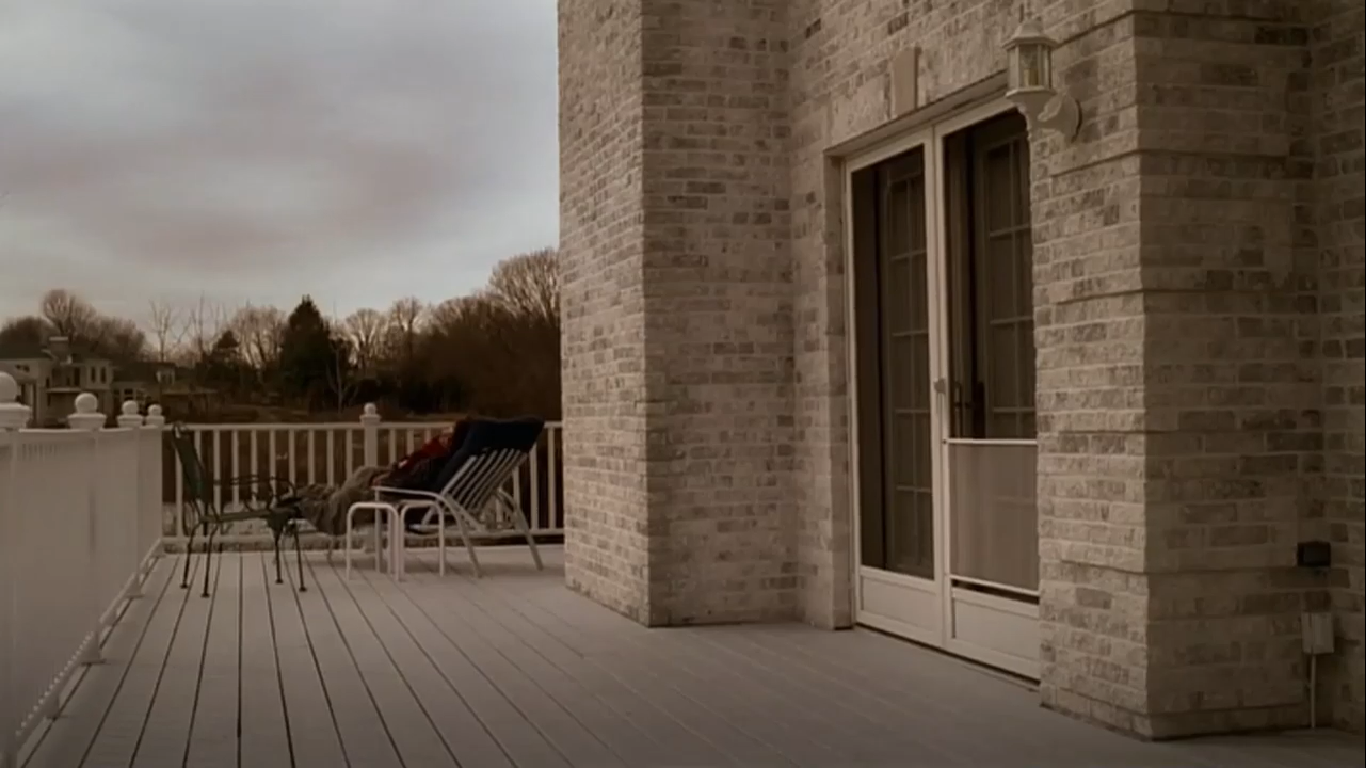

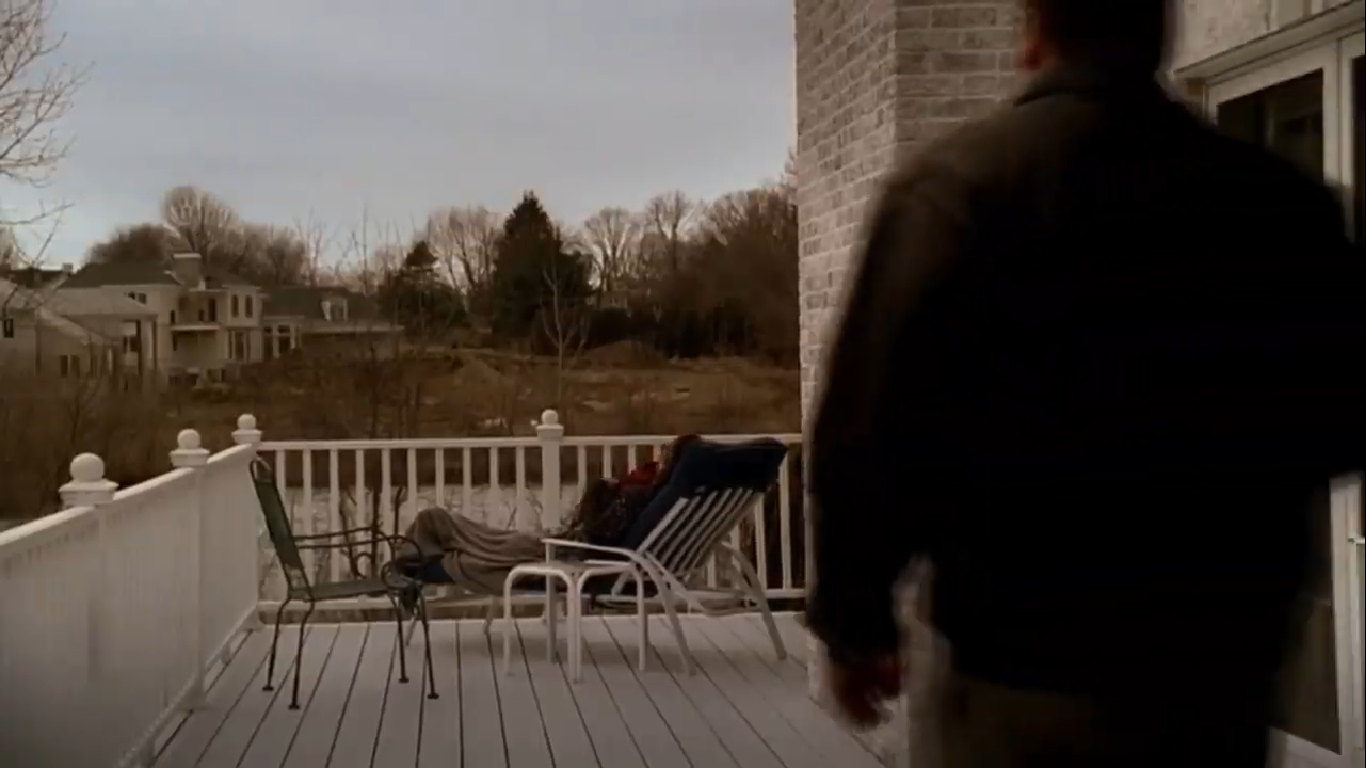
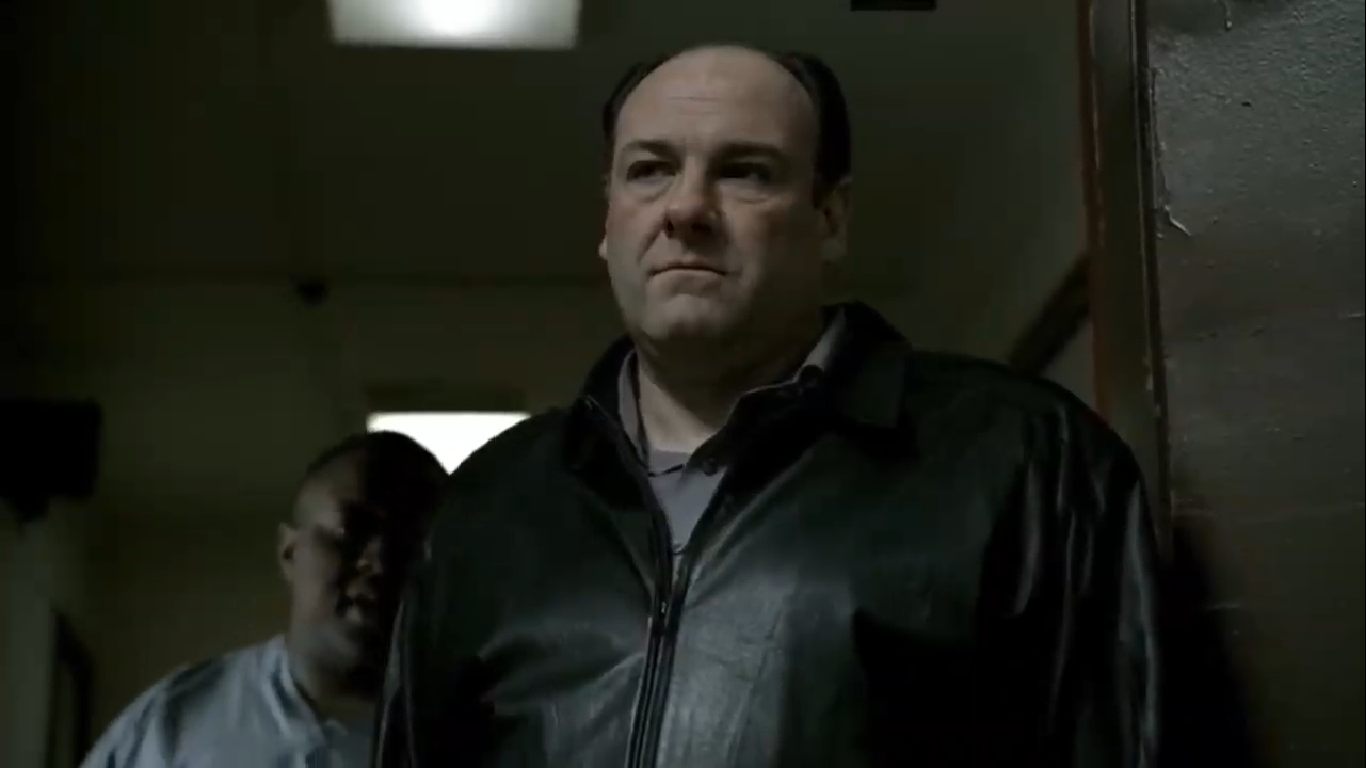 Tony POV shot of Junior.
Tony POV shot of Junior.
